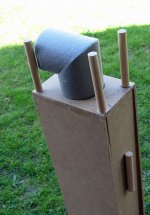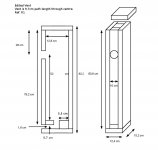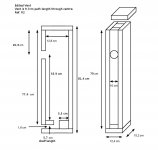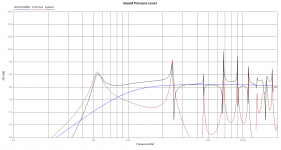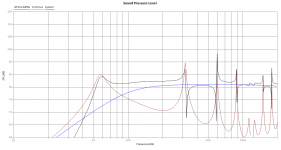Simulated versus measured tuning - length of port
Hi
I had a discussion with Troels Gravesen years back, He found that measured tuning was lower than predicted. Meaning the port should be shorter.
This is caused by the mass of the air at te opening.
MJK´s software includes this parameter in the models.
Yes, TABAQ has a longer port compared to the sim. Lowering the tuning a few Hz.
Actually, the line is made by the following parts:
This alteration was driven by my idea of the final design, and i was very pleased with the result when I had made the first prototype.
If you want to make it 100% right, you should make an external tube at the bottom of the enclosure. The commercial version of TABAQ is made this way (Kvart&Bølge).
Using an external port will also give you the opportunity to easily adjust length and cross section, if you want to make your own, personal version optimized for your driver of choice. Then try to adjust stuffing and BSC and you will have fun for many hours to come
Hi
Bjørn
Hi
I had a discussion with Troels Gravesen years back, He found that measured tuning was lower than predicted. Meaning the port should be shorter.
This is caused by the mass of the air at te opening.
MJK´s software includes this parameter in the models.
Yes, TABAQ has a longer port compared to the sim. Lowering the tuning a few Hz.
Actually, the line is made by the following parts:
- From driver to the closed end.
- From driver to the "shelf" at the start of the port.
- 12 mm line between the "shelf" and the back wall.
- The last part of the port, including the front baffle.
This alteration was driven by my idea of the final design, and i was very pleased with the result when I had made the first prototype.
If you want to make it 100% right, you should make an external tube at the bottom of the enclosure. The commercial version of TABAQ is made this way (Kvart&Bølge).
Using an external port will also give you the opportunity to easily adjust length and cross section, if you want to make your own, personal version optimized for your driver of choice. Then try to adjust stuffing and BSC and you will have fun for many hours to come
Hi
Bjørn
Hi
I had a discussion with Troels Gravesen years back, He found that measured tuning was lower than predicted. Meaning the port should be shorter.
This is caused by the mass of the air at te opening.
MJK´s software includes this parameter in the models.
Yes, TABAQ has a longer port compared to the sim. Lowering the tuning a few Hz.
Actually, the line is made by the following parts:
- From driver to the closed end.
- From driver to the "shelf" at the start of the port.
- 12 mm line between the "shelf" and the back wall.
- The last part of the port, including the front baffle.
This alteration was driven by my idea of the final design, and i was very pleased with the result when I had made the first prototype.
If you want to make it 100% right, you should make an external tube at the bottom of the enclosure. The commercial version of TABAQ is made this way (Kvart&Bølge).
Using an external port will also give you the opportunity to easily adjust length and cross section, if you want to make your own, personal version optimized for your driver of choice. Then try to adjust stuffing and BSC and you will have fun for many hours to come
Hi
Bjørn
Bjørn,
Thank you for sharing the extra details. Maybe I can stop frowning at my TL simulations now.
I already thought that having a return up the back of the shelf (an "L") would move the port "up" the cabinet. Giving some more flexibility regarding tuning.
Juggling the simulation with being able to physically build it is another matter.
The idea of a bottom of the cabinet port would seem to offer the above too. As well as the ability to fine tune the port frequency.
Regards,
J.
Bjørn, you mention the '12 mm line between the "shelf" and the back wall.'
This 12mm length line has a cross section 38mm wide by 100mm, the 38mm being the distance from the rear edge of the shelf to the back wall. How was 38mm chosen? And is it important? Maybe this will help Jerms with his sims.
I've edited the TABAQ build diagram to give a vent length of 9.7cm as per the geometry for the sim as seen in the vandalised (sorry Bjørn!) picture attached. Any reason why this would not work well in reality?
Thanks for all your assistance
This 12mm length line has a cross section 38mm wide by 100mm, the 38mm being the distance from the rear edge of the shelf to the back wall. How was 38mm chosen? And is it important? Maybe this will help Jerms with his sims.
I've edited the TABAQ build diagram to give a vent length of 9.7cm as per the geometry for the sim as seen in the vandalised (sorry Bjørn!) picture attached. Any reason why this would not work well in reality?
Thanks for all your assistance
Attachments
try to adjust stuffing and BSC and you will have fun for many hours to come
Just quess how I really know
Hi Bjørn,
I'm glad you like the mod! See attachment for R2 version of the diagram for the original TABAQ, with driver relocated and updated cabinet measurements to match the master geometry model. Do double-check the measurements if they look wrong!
My plan now is to model a shorter version of the TABAQ, perhaps just half the height but with changes to the vent to make it work, if this is even possible. A Tabaquette maybe?!
Thanks, Rob
I'm glad you like the mod! See attachment for R2 version of the diagram for the original TABAQ, with driver relocated and updated cabinet measurements to match the master geometry model. Do double-check the measurements if they look wrong!
My plan now is to model a shorter version of the TABAQ, perhaps just half the height but with changes to the vent to make it work, if this is even possible. A Tabaquette maybe?!
Thanks, Rob
Attachments
Hi jpeezy
I have done sims some years ago
http://www.diyaudio.com/forums/full-range/88787-tabaq-tl-tang-band-49.html#post3292265
I have done sims some years ago
http://www.diyaudio.com/forums/full-range/88787-tabaq-tl-tang-band-49.html#post3292265
^^^What he said. 
Play with it in the TL software.
The tuning frequency of the port is determined both by the length of the pipe (1/4 wave theory) and the volume of the enclosure (Helmholtz effect/resonator and traditional Bass Reflex cabinet port theory).
Essentially, for the same port geometry, reducing cabinet length or cabinet volume will raise the frequency of the port.
J.
Play with it in the TL software.
The tuning frequency of the port is determined both by the length of the pipe (1/4 wave theory) and the volume of the enclosure (Helmholtz effect/resonator and traditional Bass Reflex cabinet port theory).
Essentially, for the same port geometry, reducing cabinet length or cabinet volume will raise the frequency of the port.
J.
Does the length of the main section even matter? Playing with the Leonard software - when you add stuffing the whole graph gets damped to almost match the infinite baffle line whatever the length.
Without stuffing, shortening the main section just moves the harmonics a bit higher. Adjusting the vent length affects things so having a longer vent compensates for a shorter main section.
In a parallel-sided, open-ended TL I can see how the length affects the tuned freq., below which bass will roll off. But closing off the end then adding another (lower CSA) section effectively lengthens the tuned length doesn't it? This is the Mass-Loading. So that will compensate. Or am I missing something? I'll do some more reading around it I think!
R
Without stuffing, shortening the main section just moves the harmonics a bit higher. Adjusting the vent length affects things so having a longer vent compensates for a shorter main section.
In a parallel-sided, open-ended TL I can see how the length affects the tuned freq., below which bass will roll off. But closing off the end then adding another (lower CSA) section effectively lengthens the tuned length doesn't it? This is the Mass-Loading. So that will compensate. Or am I missing something? I'll do some more reading around it I think!
R
Hi
The port is actually a part of the line just with a smaller cross section.
I have, of course, tried to sim very long ports (above 5") but you get problems with dips and peaks.
Another problem with long ports is than the total volume of the pipe decreases. Meaning lower output from the opening.
Hi
Bjørn
The port is actually a part of the line just with a smaller cross section.
I have, of course, tried to sim very long ports (above 5") but you get problems with dips and peaks.
Another problem with long ports is than the total volume of the pipe decreases. Meaning lower output from the opening.
Hi
Bjørn
58cm TABAQ
Hey Bjørn, thanks for the info.
I've made a couple of plots (without stuffing) using the Leonard TL software, both simulated using the W3-315SC driver parameters.
The first plot is the standard TABAQ design (from the master geometry) which to me looks like a match to your undamped TABAQ plot (as shown in your TABAQ vs Circlo PDF).
The second plot is of a shortened TABAQ (~58cm) with a 12.5cm long vent. These measurements were arrived at using the "Accidental ML-TL" idea of using WinISD to generate a volume, plus vent length with 0.5Sd as the CSA. From there I used your TABAQ CSA (4Sd) to get main section length from the volume.
My main observations about the plots are:
Rob
Hey Bjørn, thanks for the info.
I've made a couple of plots (without stuffing) using the Leonard TL software, both simulated using the W3-315SC driver parameters.
The first plot is the standard TABAQ design (from the master geometry) which to me looks like a match to your undamped TABAQ plot (as shown in your TABAQ vs Circlo PDF).
The second plot is of a shortened TABAQ (~58cm) with a 12.5cm long vent. These measurements were arrived at using the "Accidental ML-TL" idea of using WinISD to generate a volume, plus vent length with 0.5Sd as the CSA. From there I used your TABAQ CSA (4Sd) to get main section length from the volume.
My main observations about the plots are:
- On the TABAQ plot between 240Hz and 480 Hz the line goes from minus-infinity to horizontal then to plus-infinity. On the 58cm TABAQ in the corresponding section 320Hz to 600Hz the line goes from minus-infinity to horizontal then to minus-infinity. Is this important?
- On the 58cm plot between 1000 and 1500Hz there is some mess. I levelled it a little by adjusting driver position, but again is this relevant and will it show up audibly after stuffing?
- Have I missed something obvious? I have no idea what the "ideal" un-stuffed plot should look like - where each saddle and inversion should be, whether each saddle is u or n 'polarity', etc. But if points 1 and 2 don't matter, how will building the smaller cab with these other measurements sound different (in theory)?
Rob
<From the hammock under the shade of the tree>
Having used Leonard TL for a while...
I've come to think that having a gentle slope from the fundamental DOWN to the 3rd harmonic (first spikes) on the undamped plot is beneficial. Once damped, or stuffed, the port output reduces in line with stuffing density.
Secondly.... You can adjust the "slope" between the fundamental and the 3rd harmonic by adjusting the driver placement. If you eliminate the 3rd harmonic, you flatten the plot in between them. This may cause larger "effects" higher up in the plot.... For Tabaq and other single fullrange driver designs it may be more important to have a smoother response higher up.
J.
Having used Leonard TL for a while...
I've come to think that having a gentle slope from the fundamental DOWN to the 3rd harmonic (first spikes) on the undamped plot is beneficial. Once damped, or stuffed, the port output reduces in line with stuffing density.
Secondly.... You can adjust the "slope" between the fundamental and the 3rd harmonic by adjusting the driver placement. If you eliminate the 3rd harmonic, you flatten the plot in between them. This may cause larger "effects" higher up in the plot.... For Tabaq and other single fullrange driver designs it may be more important to have a smoother response higher up.
J.
On the TABAQ plot between 240Hz and 480 Hz the line goes from minus-infinity to horizontal then to plus-infinity. On the 58cm TABAQ in the corresponding section 320Hz to 600Hz the line goes from minus-infinity to horizontal then to minus-infinity. Is this important?
Rob,
I'm a little confused? Which "line" goes from minus infinity to plus infinity? I don't see it in your plots. Maybe it was me that missed something...
That said, I like your short version (58 cm) with the longer port, as much if not better than the long one.
There is a point at which the port becomes too long. But at that point your model will show the terminus SPL near your tuning frequency begin to fall off as you try making it longer. But your sim shows virtually the same terminus output for both versions, so the 58 cm version looks just fine to me.
Second, IMHO you should put far more weight on what you see at low frequency (say below about 500 Hz), than what you see at higher frequencies. In fact, I suggest you absolutely ignore anything you see over 1000 Hz. Or rather, especially ignore the terminus output over 1000 Hz. The reason being this: any normal stuffing strategy will virtually eliminate the contribution of the terminus (regardless of what the LATL model suggests) in that frequency range.
And the corollary that follows from that (IMHO), is that you should place the driver higher (maybe closer to where you were putting in originally), to eliminate the resonance at 240 Hz, and ignore what "damage" it may appear to do at the higher frequencies. To clean up the 240 Hz response will require much more stuffing than what it will take to clean up any higher frequency stuff, and all that stuffing will just degrade the low frequency terminus output you worked so hard to achieve with the cabinet design.
So rather than overstuff it to clean up the 240 Hz mess, just put the driver where it belongs (where the 240 Hz resonance is eliminated), and stuff lightly to preserve the full low frequency capability of the cabinet.
The further advantage of the 58 cm design with the long port is that it drives the 5/4 wave resonance from 450 Hz to nearly 600 Hz. And by doing that, you further minimize the amount of stuffing required (because high frequencies are easier to damp than lower frequencies).
I suspect my opinions here may differ from others (who may have way more experience than I do). So take them with the proverbial grain of salt.
I'm eager to hear what others think as well.
Eric
- Home
- Loudspeakers
- Full Range
- TABAQ TL for Tangband
